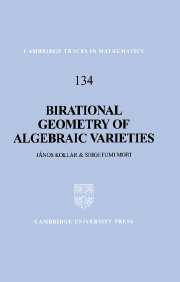Book contents
- Frontmatter
- Contents
- Preface
- Introduction
- 1 Rational Curves and the Canonical Class
- 2 Introduction to the Minimal Model Program
- 3 Cone Theorems
- 4 Surface Singularities of the Minimal Model Program
- 5 Singularities of the Minimal Model Program
- 6 Three-dimensional Flops
- 7 Semi-stable Minimal Models
- Bibliography
- Index
5 - Singularities of the Minimal Model Program
Published online by Cambridge University Press: 24 March 2010
- Frontmatter
- Contents
- Preface
- Introduction
- 1 Rational Curves and the Canonical Class
- 2 Introduction to the Minimal Model Program
- 3 Cone Theorems
- 4 Surface Singularities of the Minimal Model Program
- 5 Singularities of the Minimal Model Program
- 6 Three-dimensional Flops
- 7 Semi-stable Minimal Models
- Bibliography
- Index
Summary
The aim of this chapter is to study the higher dimensional singularities that occur in the minimal model program.
In the first section we study properties of Cohen–Macaulay and of rational singularities. These results belong more to general algebraic geometry than to the minimal model program. We develop their theory only to the extent necessary for our purposes.
In section 2 we investigate local properties of dlt pairs. One of the most important results is that they are rational (5.22). An important consequence of this is that we can frequently work with ℚ-Cartier Weil divisors as if they were Cartier (5.26, 5.27).
Section 3 is devoted to a detailed study of 3-dimensional terminal and canonical singularities. First we relate them to Du Val and elliptic surface singularities (5.34,5.35). Then we apply the results of Chapter 4 to their study. The complete classification of 3-dimensional terminal singularities is stated in (5.43), though we do not need this result in the sequel.
In section 4 we gather various results concerning adjunction and inversion of adjunction. Inversion of adjunction is a process that frequently allows one to reduce a problem concerning dlt pairs to a lower dimensional question. The main result is (5.50). Similar techniques can also be used to study the reduced part of the boundary of dlt pairs. Such results become important in Chapter 7.
Section 5 gives a quick introduction to the duality theory of CM sheaves.
Starting with this chapter, we encounter several theorems which are essentially local in nature, but their proofs are much easier for projective varieties. One of the best examples is (5.22).
- Type
- Chapter
- Information
- Birational Geometry of Algebraic Varieties , pp. 152 - 186Publisher: Cambridge University PressPrint publication year: 1998

